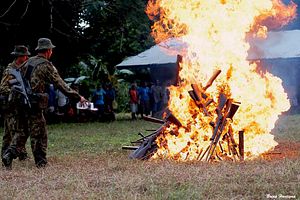The Regional Assistance Mission to Solomon Islands (RAMSI) will officially come to a completion on Friday, June 30. For the past 14 years the Australian-led mission has been assisting the Pacific Island country to reestablish stability and functionality after a period of ethnic violence from 1998 to 2003. During this period hundreds of people were killed, ten of thousands displaced, and the state was brought almost to collapse.
As a modern nation-state constructed out of a British colonial endeavor, the Solomon Islands brought together six large culturally distinct islands (and another 900 smaller islands) alongside 70 languages. Despite the creole of Pijin (closely related to Papua New Guinea’s Tok Pisin) developing throughout the colonial period as a lingua franca, an accompanying strong civic nationalism that could have transcended tribal divisions had failed to develop alongside it.
The second half of the 20th Century saw significant movement of people from the island Malaita, who were seeking opportunities in the capital of Honiara on the island Guadalcanal. Malaitans soon became the largest ethnic group in the capital and the dominant actors in many of the government’s structures and business community. This led to significant resentment within the native Guale population. The increasing tensions led to the formation of two militia groups, the Isatabu Freedom Movement and the Malaita Eagle Force. Law and order began to collapse along with the state’s ability to deliver services, and economic activity was diminished.
Prior to 2003, Australia had been reluctant to intervene in the conflict. Australia’s role in the recent independence of Timor-Leste had aroused Indonesian suspicions of potential Australian sympathy towards the independence movement in West Papua. The thinking was that any use of military force in the region could have been perceived by Indonesia as an Australian fondness for regional interventions, compounding suspicions of Australia’s disregard for Indonesian sovereignty.
Yet with the invitation of the Solomon Islands’ government, and with increased concern about a failing state in Australia’s “arc of instability,” the RAMSI intervention was launched with the support of the Pacific Islands Forum.
Violence came to an almost immediate halt with the RAMSI intervention, and within a few weeks most of the militias’ weaponry had been confiscated and destroyed. Although Australia provided the bulk of the 2,200 military personnel and police, the other 15 member states of the Pacific Islands Forum all contributed some police and military personnel, as well advisors and diplomats to assist in the reconstruction of the state.
The mission was devised not simply as a peacekeeping operation, but as a program to rebuild the state. This involved significant investment in not only the Solomon Islands’ security apparatuses, but also within the country’s financial infrastructure, the justice system, and vital public services like health and education. Alongside reviving the country’s economy and building more inclusive civic institutions.
In a statement to the Solomon Islands Parliament on Tuesday, Prime Minister Manasseh Sogavare recognized the success of this state-building project when he declared that “[l]aw and order has been restored, the machinery of Government is functioning again, the economy has recovered and the judicial system has been strengthened; our Police Force has regained the confidence of our people.”
RAMSI has remained popular with with general population throughout its mission, and some sections of the Solomon Islands community are concerned that unrest will return when it departs. While government corruption in the Solomon Islands remains an endemic problem, and former warlord Jimmy Lusibaea is now the Infrastructure Minister, the chief of the RAMSI mission, Quinton Devlin, has stressed that the creation of a perfect state was never RAMSI’s purpose. The mission was to restore stability to the country and assist in establishing institutions that the Solomon Islands can continue to develop themselves.
However, the success of RAMSI, once it fully departs the Solomon Islands on Friday, will be judged by whether this stability and security can be maintained, and whether the country’s revived institutions have the resilience to withstand the transition back to full sovereignty, and to accommodate the evolving needs of the Solomon Islands’ people.
For Australia, the end of RAMSI will signal a potential shift in Australia’s regional foreign policy. Will Australia continue to pursue a more active and interventionist foreign policy, or moves back towards the more reluctant position held prior to RAMSI, weary of Indonesia’s concerns. Of course the hope is that further interventions of this kind will not be necessary – particularly in the Solomon Islands – however the forthcoming referendum on Bougainville’s independence from Papua New Guinea (currently scheduled for mid-2019) will undoubtedly be carefully observed by the Australian government.
































